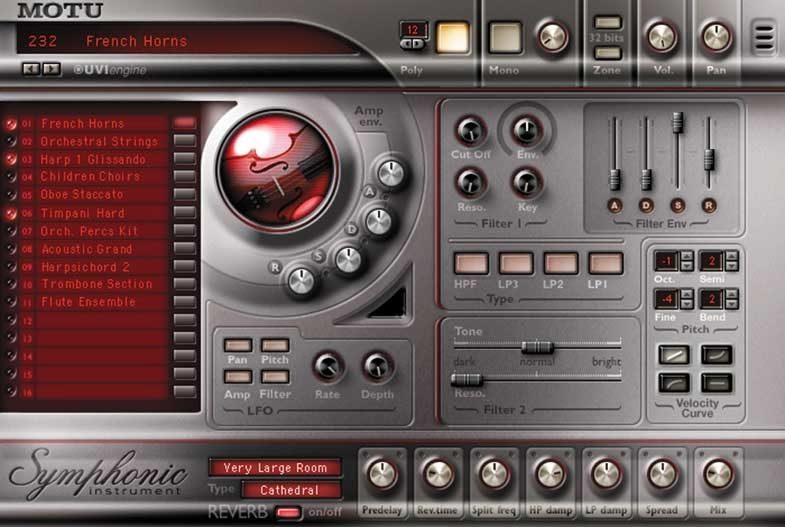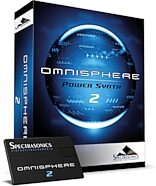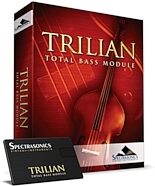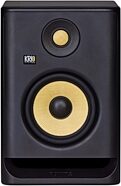MOTU Symphonic Instrument Soft Synth (Macintosh and Windows)
No longer available at zZounds



Be the conductor with this huge 8 GB library of strings, woodwinds, brass and other realistic orchestral sounds.
Overview
The MOTU Symphonic Instrument is a cross-platform instrument plug-in that gives users quick and easy access to an enormous 8GB library of quality orchestra sounds for composing, sequencing and rendering realistic orchestral performances. The MOTU Symphonic Instrument can be used with any compatible host application (VST, Audio Units, DXi, MAS and RTAS), where users can load up to sixteen different instruments per instance of the plug-in to create ensembles of any size and scope. Built-in convolution reverb allows users to place their ensemble in authentic acoustic spaces, from orchestra sound stages to renowned concert halls to majestic cathedrals. Easy to use controls let users further adjust each instrument to achieve the perfect sound. Sounds can also be directly loaded into MOTU's MachFive universal sampler plug-in for more advanced layering and programming.
Strings - Violin Section, Viola Section, Cello Section, Bass Section, Solo Violin, Solo Viola, Solo Cello, Solo Bass, Harp...
Brass - Trumpet solo, Trumpet ensemble, Piccolo Trumpet, Flugel Horn, French Horn solo, French Horn ensemble, Trombone solo, Trombone ensemble, Bass Trombone, Tuba, Contrabass Tuba...
Woodwinds - Flute solo, Flute ensemble, Alto Flute, Piccolo, Clarinet solo, Clarinet ensemble, Bass Clarinet solo & ensemble, Oboe solo, Oboe ensemble, Oboe D'Amore, Bass Oboe, English Horn, Bassoon solo & ensemble, Contra Bassoon...
Orchestral Percussion - Timpani, Orchestral Cymbals, Orchestral Snare & Bass Drum, Gong, Tubular Bells, Mallets, Celesta, Glockenspiel Marimba, Vibraphone, Xylophone...
Tutti - Complete Orchestra, String Orchestra, Brass Orchestra...
Choirs - Women's Choir, Men's Choir, Children's Choir, Solo Soprano, Solo Tenor...
Pipe Organ - Baroque Organ, Romantic (cathedral) Organ
Piano - Steinway D, Yamaha C7...
Historical Instruments - Harpsichords, Piano Forte, Viole...
The Acoustic Spaces Convolution is a process where the characteristics of a real acoustic space are sampled (captured) and then faithfully reproduced, down to the last detail and nuance. Convolution reverbs are known for their stunning realism and are widely considered to be the best type of reverb that money can buy. Users can choose from a wide variety of acoustic spaces included with the MOTU Symphonic instrument to greatly enhance the realism of their orchestral recordings. Highlights include ensemble chambers, concert halls and soaring cathedrals.
The plug-in
The MOTU Symphonic Instrument provides 16-part multitimbral operation via the part list on the left-hand side of the window. Users choose the desired instrument for each part and assign a MIDI channel. To layer two or more instruments so that they play the same notes, users simply assign the parts to the same MIDI channel. Instruments to be played separately are assigned a unique MIDI channel. The controls to the right of the part list allow users to adjust the sound of the currently selected instrument, including ADSR amplitude envelope controls, an LFO, two filters, tone controls, pitch controls and… read more velocity response. Global parameters, such as maximum allowed polyphony and global volume/pan, are displayed across the top of the window. Finally, the bottom portion of the window displays controls for the convolution reverb, including a menu for choosing the desired acoustic space and seven knobs for further adjusting the sound of the space. The MOTU Symphonic instrument is driven by the 32-bit UVI engine, acclaimed worldwide for its lush and powerful sound.The Sounds
From solo instruments and small ensembles to full tutti orchestra and choirs, the MOTU Symphonic Instrument's massive 8 gigabyte (GB) library provides sounds from world class orchestras and musicians, recorded with pristine audio fidelity and careful attention to detail. Quality and variety abound: strings, brass, woodwinds, orchestral percussion, male and female choirs, pipe organs, period instruments and pianos and even timeless classics, including Steinway D and Yamaha C7 pianos. Instrument highlights include:Strings - Violin Section, Viola Section, Cello Section, Bass Section, Solo Violin, Solo Viola, Solo Cello, Solo Bass, Harp...
Brass - Trumpet solo, Trumpet ensemble, Piccolo Trumpet, Flugel Horn, French Horn solo, French Horn ensemble, Trombone solo, Trombone ensemble, Bass Trombone, Tuba, Contrabass Tuba...
Woodwinds - Flute solo, Flute ensemble, Alto Flute, Piccolo, Clarinet solo, Clarinet ensemble, Bass Clarinet solo & ensemble, Oboe solo, Oboe ensemble, Oboe D'Amore, Bass Oboe, English Horn, Bassoon solo & ensemble, Contra Bassoon...
Orchestral Percussion - Timpani, Orchestral Cymbals, Orchestral Snare & Bass Drum, Gong, Tubular Bells, Mallets, Celesta, Glockenspiel Marimba, Vibraphone, Xylophone...
Tutti - Complete Orchestra, String Orchestra, Brass Orchestra...
Choirs - Women's Choir, Men's Choir, Children's Choir, Solo Soprano, Solo Tenor...
Pipe Organ - Baroque Organ, Romantic (cathedral) Organ
Piano - Steinway D, Yamaha C7...
Historical Instruments - Harpsichords, Piano Forte, Viole...
The Acoustic Spaces Convolution is a process where the characteristics of a real acoustic space are sampled (captured) and then faithfully reproduced, down to the last detail and nuance. Convolution reverbs are known for their stunning realism and are widely considered to be the best type of reverb that money can buy. Users can choose from a wide variety of acoustic spaces included with the MOTU Symphonic instrument to greatly enhance the realism of their orchestral recordings. Highlights include ensemble chambers, concert halls and soaring cathedrals.
MachFive Compatibility
If users prefer the more advanced and flexible environment provided by MachFive, MOTU's universal sampler plug-in, they can freely load the MOTU Symphonic Instrument sounds into MachFive for more complex layers, splits and stacks. In fact, users can bring the full weight of MachFive's Expert Mode to bear on designing their own dynamic instruments and ensembles. read lessSpecs
iLok compatible
Reviews
Reviewers gave this product an overall rating of 0.5 out of 5 stars.
(41 ratings)
Submitted August 20, 2005 by a customer from peoplepc.com
"Caveat Emptor!"
Verified Customer
zZounds has verified that this reviewer made a purchase from us.
I've already uninstalled the product and written it off. I have some especially good soundfonts from Sonic Implants and Soundfonts.de, so it was only selected instruments that I needed. At this point, I'm hoping against hope that Sonic Implants will relent and convert the rest of their Symphonic Orchestra to soundfont format. But I'm not risking buying any more products like this.
Sound
Sound is about average. Problem is that MOTU spreads their available MB too thin. They provide a dozen mediocre versions of an instrument instead of a few good versions. In my case, with Windows and SONAR 4 Producers Edition, there were stuck notes on some instruments and clicks on all instruments. Some instruments, like the timpani roll, were a joke. It crescendos then decrescendos for the duration of the note, and there's nothing you can do about it.
Features
On paper, the product had EQ and Reverb and other useful features, but at least with Windows and SONAR, any attempt to use these features either crashed SONAR or crashed the whole operating system.
Quality
This product has just come out, so one shouldn't be surprised that it has bugs. That it has the bugs it has, however, is another matter. Maybe the product works better on a Mac or with Mac software, but on Windows and with SONAR, it exhibits the behavior of a piece of software that is about midway through the testing/debugging… read more process.
Value
If you plan to use it on Windows, be careful. If you plan to use it on Windows with SONAR, forget it. It isn't worth the risk.
Manufacturer Support
The tech reps wanted to help, and some seemed more knowledgeable than others. One remarkable plus is that one could actually get them on the phone! But no, they did not solve the problem. I worked with them for over two weeks, trying to tweak SONAR to make their clicks and stuck notes go away. In the end, since the quality of the instruments was no better than what I was already using, I simply uninstalled the program and put it on the shelf.
The Wow Factor
The hype surrounding the product certainly sounded good, and the number of GB they were using made it sound as though they had some good instruments here. As I said, the instruments turned out to be mediocre, though they could have been good if more MB had been alloted to each one. The Concert Piano, for instance, is good (and it has over 100 MB devoted to it, whereas the violins have 30 and are mediocre).
Musical Background:
composer
Musical Style:
orchestral - light classical read less
Sound
Sound is about average. Problem is that MOTU spreads their available MB too thin. They provide a dozen mediocre versions of an instrument instead of a few good versions. In my case, with Windows and SONAR 4 Producers Edition, there were stuck notes on some instruments and clicks on all instruments. Some instruments, like the timpani roll, were a joke. It crescendos then decrescendos for the duration of the note, and there's nothing you can do about it.
Features
On paper, the product had EQ and Reverb and other useful features, but at least with Windows and SONAR, any attempt to use these features either crashed SONAR or crashed the whole operating system.
Quality
This product has just come out, so one shouldn't be surprised that it has bugs. That it has the bugs it has, however, is another matter. Maybe the product works better on a Mac or with Mac software, but on Windows and with SONAR, it exhibits the behavior of a piece of software that is about midway through the testing/debugging… read more process.
Value
If you plan to use it on Windows, be careful. If you plan to use it on Windows with SONAR, forget it. It isn't worth the risk.
Manufacturer Support
The tech reps wanted to help, and some seemed more knowledgeable than others. One remarkable plus is that one could actually get them on the phone! But no, they did not solve the problem. I worked with them for over two weeks, trying to tweak SONAR to make their clicks and stuck notes go away. In the end, since the quality of the instruments was no better than what I was already using, I simply uninstalled the program and put it on the shelf.
The Wow Factor
The hype surrounding the product certainly sounded good, and the number of GB they were using made it sound as though they had some good instruments here. As I said, the instruments turned out to be mediocre, though they could have been good if more MB had been alloted to each one. The Concert Piano, for instance, is good (and it has over 100 MB devoted to it, whereas the violins have 30 and are mediocre).
Musical Background:
composer
Musical Style:
orchestral - light classical read less
10 of 11 people (91%) people found this review helpful. Did you?
Thanks for your opinion!
No longer available at zZounds
In most cases, a product is unavailable because it has been discontinued by the manufacturer
This is a carousel with product cards. Use the previous and next buttons to navigate.











